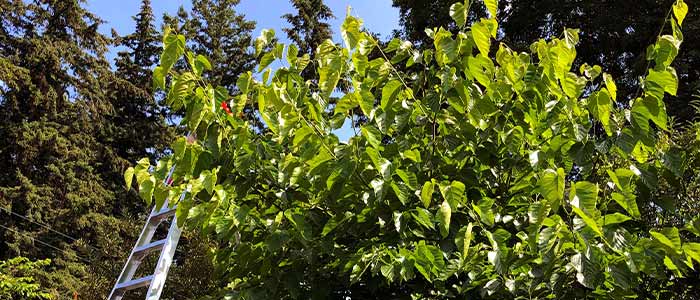- Shop
- Apparel
- Berries
- Books
- Bundles
- Citrus
- Fertilizer & Pest Control
- Fruiting Ground Covers
- Fruiting Shrubs
- Fruiting Trees
- Herbs, Spices, and Teas
- Mason Bees
- Nitrogen Fixers and Companion Plants
- Northwest Natives
- Nut Trees
- Ornamentals & More
- Perennial Vegetables
- Rootstock
- Subtropical Fruits
- Tools
- Vines
- Xeriscape
- Sale Items
- Information
- Nursery News
- Contact Us
- My Account

Summer Care Checklist for Fruit Trees
With summertime arriving, fruit trees are actively growing, developing fruits, and producing their buds and branches for next year. The fruit tree’s roots are drinking in the beneficial nutrients from the soil and their leaves are absorbing the energy from the sun’s rays needed to keep them growing and thriving. As daily temperatures increase so does the care needed for fruit trees during these extra sunny days. Even for those living in more mild climates there are still some preparations to be made that can help your plants thrive this summer.
1. Increase watering – It’s time to start turning on your drip systems and get the water flowing to your trees! We’ve had quite the mild and cool start to summer here in Portland but don’t let the late spring drizzles fool you, most of that rainfall doesn’t penetrate below the canopy or into the soil. Deep waterings throughout the summer will keep your tree hydrated, reduce stress , limit diseases and give you better quality fruits.
2. Begin summer pruning – Summer is an ideal time to prune back trees to help control vigor and promote healthy growth. July and August are recommended months for summer pruning as woody plants aren’t pushing as much tender new growth and have settled in for the photosynthetic adventure of summer. During this time it is recommended to inspect trees and prune back any damaged, dead, or diseased branches. Be sure there is enough spacing in-between branches to have steady sun and air flow, and remove any overlapping branches. To stimulate growth for a strong structure, it is recommended to prune back any spindly or weak new growth. Keep in mind that summer pruning is designated for minor upkeep and it’s important to not prune too excessively. Late fall and winter pruning is for more drastic branch removal. Certain trees such as apricots, cherries, peaches, plums and nectarines should only be pruned in summer as their knack for getting all sorts of various diseases makes winter pruning problematic. Pruning during the dry summer months helps keep these trees disease free!
3. Fruit Thinning- It’s not too late to thin the fruit on your tree. Many varieties will produce multiple fruits in a given flower cluster which causes fruits to be smaller, more susceptible to disease, and less sweet. Thinning your fruit allows the tree to direct more energy into less fruits and also keeps your fruits from rubbing against each other as they ripen and enlarge. This can be a difficult task for many gardeners because it’s hard to see young fruits thrown to the ground after all that time spent raising your tree but the reward is larger, healthier and tastier fruits. Thinning fruit can also help trees from going into biennial bearing cycles.
4. Weeding – Be sure to continue removing any uninvited plants to reduce competition within the root system underground. It is also recommended to apply at least 2-3 inches of mulch on the topsoil to help limit the amount of weed growth, retain soil moisture and build soil.
5. Pest and Disease Control – Typically by summertime there’s not a lot you can do about the fungal diseases that found their way in during the cool, wet months but you can still protect your tree from pests. Aphids, scale and mealy bug are some of the most common garden pests and your bound to find them on at least a few plants each year. Attracting pest predators is always helpful but if the ladybugs and parasitic wasps aren’t keeping things in order you can always try organic sprays such as neem oil, soapy water mixtures or coconut or sesame oil dissolved in water. These little sap sucking pests love to hang out on the undersides of leaves or branch crevices so give your plants a good scan for them.
6. Fertilize. Now is the time to keep fertilizing! Plants are actively taking up nutrients during the warmer months and a handful of organic fertilizer can turn those yellow leaves into a lush green in just a few days during the summer. Be sure to listen to your plants for what they need as there is no “one size fits all” remedy to plant fertility. As a general rule most fruiting trees don’t need nearly as much nitrogen as vegetable plants and applying too much nitrogen can cause excessive vegetative growth and fewer fruits. Try a well rounded fruit tree fertilizer and for plants like blueberries, or any other Vaccinium species, or citrus be sure to add a fertilizer specially formulated for those acid loving plants.
7. Enjoy the bounty! – All the care and dedication gone into growing fruit trees pays off when each plant gives thanks by offering tasty fruits to enjoy in return! Summertime and early fall brings the bounty so be sure to harvest all the fruit while you can and relish in the offerings received.
